Can Berlin Fashion Week Capture — and Hold — the Industry’s Interest?
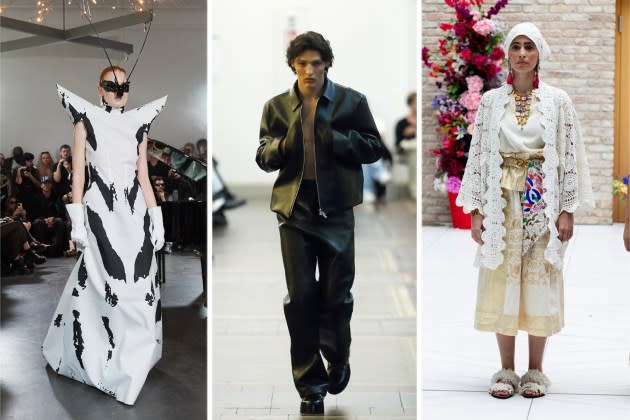
BERLIN — The organizers and designers showing at Berlin Fashion Week have said it many times. They don’t want to be another Paris, Milan or even a London. For one thing, it’s not possible. There’s just not the same level of fashion industry in Berlin, and for another, the German capital, long known for its liberal politics, artistic creativity and hedonistic nightlife, just wants to be, well, Berlin.
Still, there comes a time when international recognition becomes more important, if not for the sake of the event itself, then for the sake of local designers’ business development.
More from WWD
EXCLUSIVE: L'Agence Opens Paris Flagship and Showroom as Springboard for European Expansion
Avril Lavigne Does Couture: Behind the Scenes in Paris at the Tamara Ralph Show
“Internationalization is a central concern for us,” confirmed Michael Biel, Berlin’s state secretary for economics, whose government is funding the event to the tune of around 4.8 million euros a year. “Berlin is different — we are, if you like, our own brand. But,” he told WWD, “we don’t want a Berlin bubble.”
The city’s fashion week has been running in one form or another since 2007. But it is only really over the last two years or so that organizers have found the best timing and solidified the event’s identity.
“Word has gotten around that we are doing something fundamentally different here in Berlin, that the designers’ [own] communities are very much the focus here,” Biel contended. “With each season, international interest grows and the response is consistently positive.”
It’s early days yet, organizers and participants all agree. But how interesting is Berlin Fashion Week — or how interesting can it become — to an international audience, whose attention is usually divided between Europe’s acknowledged and industry-supported fashion capitals?
Certainly the labels in Berlin were more international this season.
In particular, the first day was dominated by a series of shows and events under the title “Intervention,” organized by Reference Studios, a Berlin-based agency with strong contacts in the European apparel industry.
These included this year’s second outing in Berlin for Anonymous Club, the brainchild of former Hood by Air founder and designer Shayne Oliver.
The Anonymous Club show was held inside Tempodrom, a popular inner city concert venue, in front of an enthusiastic audience of several thousand, many of whose outfits proved just as interesting as those on the runway.
Models walked rounds of the darkened underground hall to the thunderous rumble of industrial music. The looks themselves were mostly about the deconstruction and reconstitution of the sweatshirt — or, perhaps more accurately, thick cotton sweatshirt fabric. Twisted, paneled, slashed, draped, upside down, wrapped around heads and waists, hunch-backed, spray-painted or oversize, Oliver turned it all into an intellectual exercise in sweat shirting. Vinyl and rubber provided contrast.
“I treat it [sweatshirt fabric] a bit like tulle,” Oliver told WWD after the show. “I’m really trying not to think about the fabric too much, not obsessing about it — like, where is it coming from? Will it arrive?” In this way, focus on shape and design was sharpened.
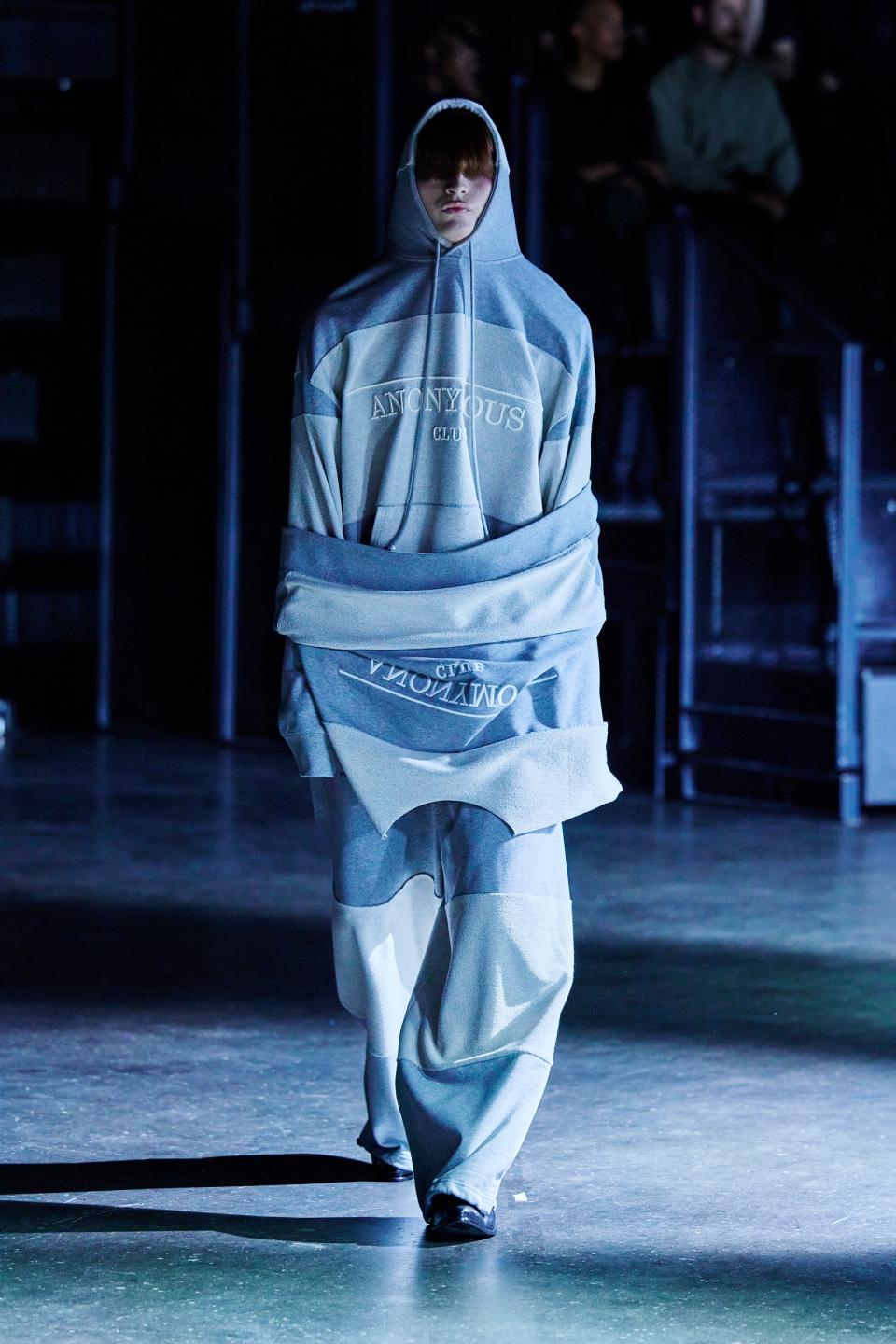
Also part of “Intervention” was the slightly surprising return to Berlin of menswear specialist GmbH, a label based in the German capital but which usually only shows and sells in Paris.
It’s surprising because in the past, GmbH’s designers Benjamin Huseby and Serhat Işık have been publicly critical about showing at home. But that was really more about the timing, Huseby explained. Previously Berlin Fashion week was scheduled during Paris Men’s Fashion Week, which is exactly when the GmbH duo can’t leave their Paris showroom.
This season GmbH chose to put on their show at home rather than Paris for several reasons, the pair said. The Paris Olympics added major logistical hurdles and the brand was celebrating its seventh anniversary and had never done anything in Berlin.
Additionally, after their last, more political show in Paris, when the designers called for peace in the Middle East in a speech that brought guests to tears, they said they wanted to support their own community here. Berlin authorities have been criticized for violently repressing protests around the issue of the Gaza conflict.
“So when we were invited, it just felt serendipitous,” Huseby explained.
Designers everywhere, he added, have been discussing the viability of the seasonal show schedule for some time now. “I don’t think it matters so much where you show now, but how,” he argued. “It’s just that whatever you do, it has to make sense.”
GmbH’s savvy collection, shown on the Tempodrom’s wide terrace, made great commercial and creative sense. It included short shorts with long, playful tassels at the pocket and risqué, bare-a-lot womenswear mixed with tailored suit jackets topped by kaftan-style hoods, alongside deceptively simple sportswear featuring subtly complex construction.
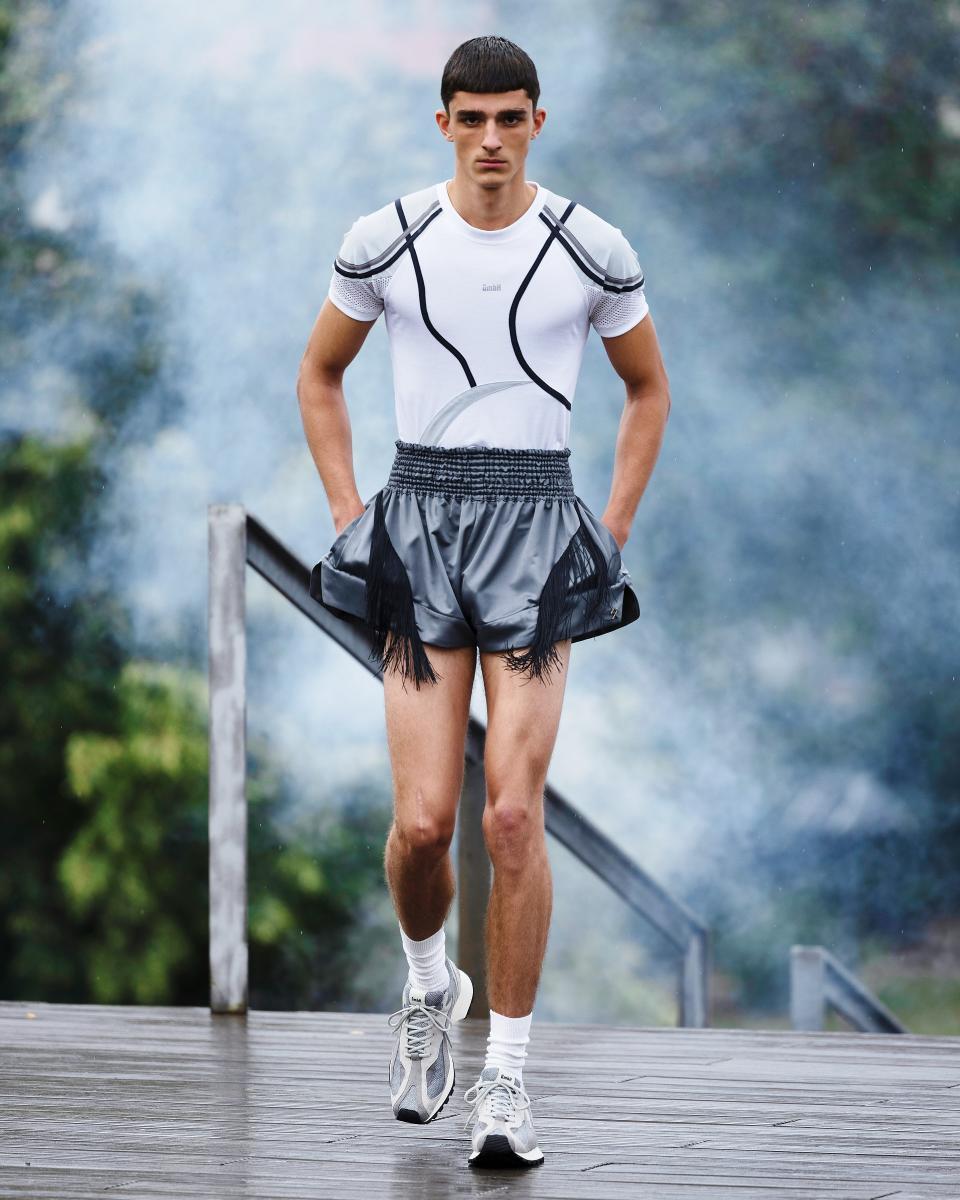
GmbH was not the only internationally successful brand convinced by Berlin this season. Munich-based label Horror Vacui agreed to put on its very first show during the week.
The 10-year-old label has been sold in boutiques like Browns and Liberty in London, Joyce in Hong Kong and online at sites like Matches and Net-a-porter for years. But founder and designer Anna Heinrichs has focused on sales out of Paris.
Heinrichs told WWD that it was Berlin Fashion Week’s new lease of life and its recent commitment to sustainability and “to nurturing and supporting designers [that] influenced our decision to present in Berlin.”
Last month Berlin Fashion Week revealed it would adopt sustainability and inclusivity guidelines very similar to those of Copenhagen Fashion Week and that these would become mandatory by February 2026.
During Horror Vacui’s show, models strolled down a long passage in the historic Kolonnadenhof, or “courtyard of colonnades,” a UNESCO World Heritage site in a central city museum’s garden.
Horror Vacui means “fear of the void” and Heinrich filled the dreaded emptiness with Liberty prints, patchwork and an array of handcrafted details, everything from smocking and scalloping to appliqué, shirring, shell hems and honeycombing. In fact, one of her maximalist white shirts could be a demonstration model for many forgotten sewing techniques, likely only kept alive these days by expert technicians working in couture.
In a formal garden, Horror Vacui’s silhouettes, inspired by historic and national costumes as well as your granny’s nightie, were feminine and sweetly opulent. But, despite all the Ladies-Who-Lunch puffs and pleats, there was also something subversive about them; somehow you could envisage wearing one of Heinrichs’ dresses running barefoot through a flowery meadow or onstage with Fleetwood Mac.
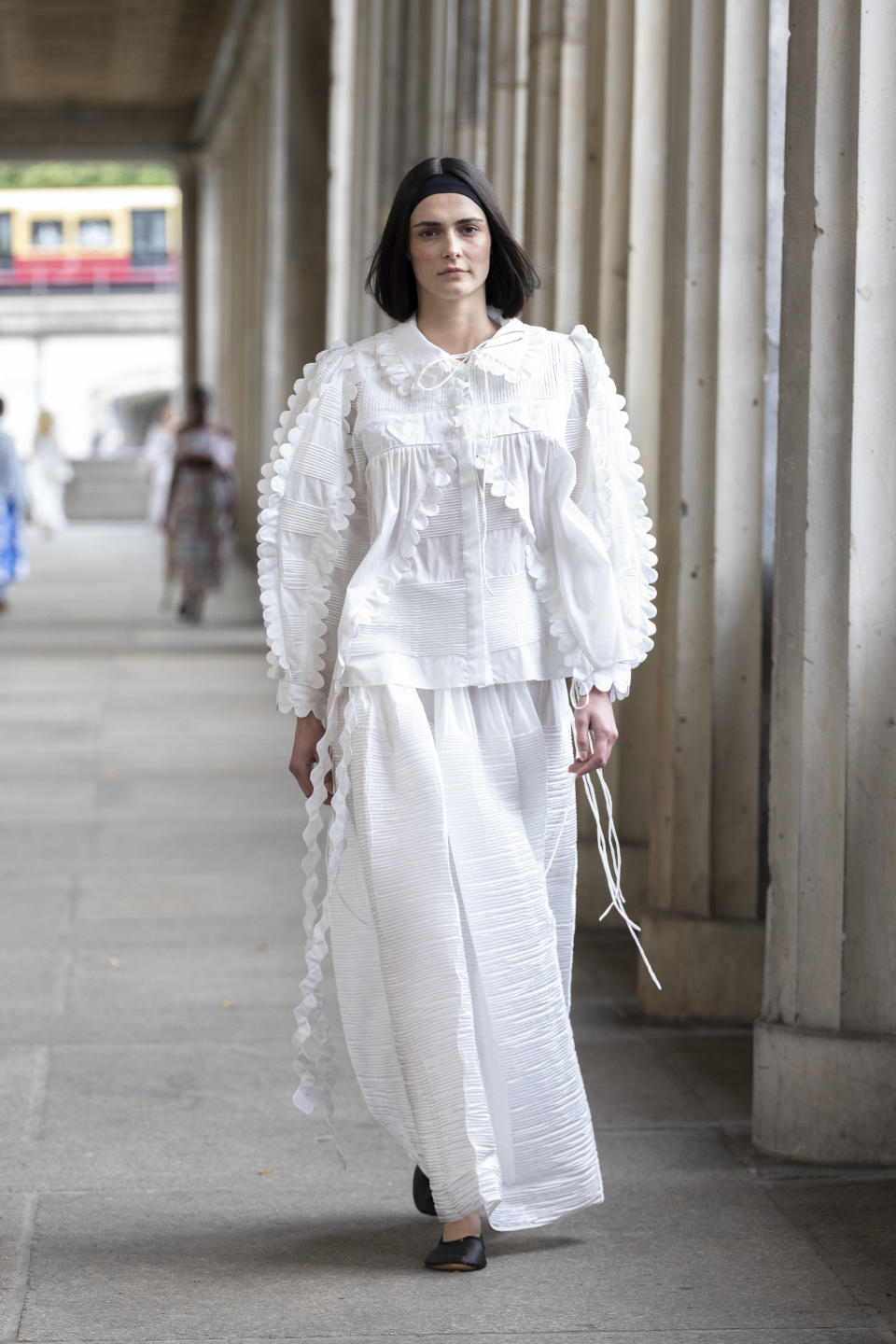
Outside of the cheerleading for the event, there’s also no doubt that the Berlin senate’s financial support, which includes footing the bill for some of the runway shows, is an added sweetener. The administrative support shows in the wide choice of venues, which included inner-city museums, galleries, warehouses, historic public swimming pools and concert venues. The smallest audiences for on-schedule shows were somewhere between 300 and 500 people.
Speaking of audiences, while the designers may have felt slightly more international, it was unclear whether the crowd was.
More people have been talking about Berlin Fashion Week in Paris, GmbH designers Huseby and Işık acknowledged. “I was actually surprised,” Huseby told WWD. “We had a lot of people coming through the showroom and they were so excited about Berlin. Everyone loves the city, they’re happy to spend time here and a lot come here anyway just to hang out. Now they get to combine that with their [professional] schedules.”
One London fashion editor explained how she was in Berlin on holiday and extended her stay to attend shows. “It does really seem as though they’re getting their act together,” she noted approvingly after Anonymous Club. “It feels like the city is finally doing its own thing.”
Rumor even had it that Ye — the artist formerly known as Kanye West — was among the crowd at Anonymous Club, having flown in from Moscow to be there. However beyond some breathless reporting by local newspapers and a series of blurry pictures on social media, this couldn’t be confirmed.
The Berlin senate has also instituted a hospitality program for international guests. But again, without all those inducements, would there be anything to attract international buyers and media to Berlin?
Over the past week, it really depended on which shows one chose to go to. Sure, there was something for the mainstream, everything from the tulle-heavy drama of Danny Reinke to Claudia Skoda’s sleek knitwear, Alan Balletshofer’s tailored sportswear and Rianna and Nina’s exotic prints, with which they outfitted traditional Greek dancers at a show inside the Greek embassy.
But the most compelling collections were probably those that really reflected the city’s unique culture. In places like Paris or New York, the biggest fashion brands with the most money have the potential to influence local culture through their campaigns and shows. But in Berlin, there’s fierce resistance to that idea. Here, at least according to what’s on the most interesting collections, the city’s culture itself influences the fashion — and not the other way around.
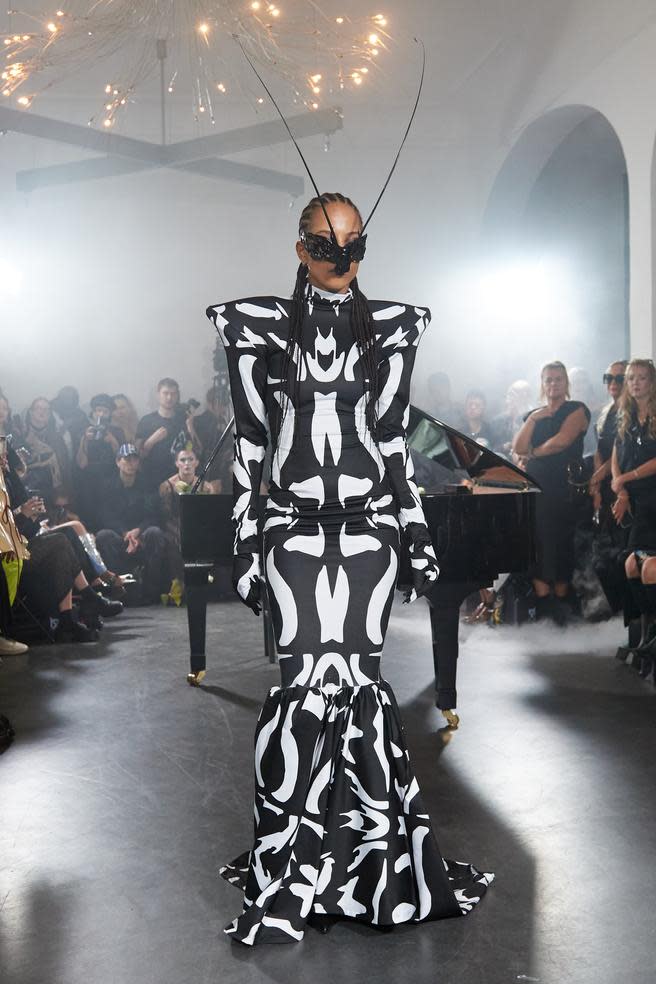
That means looks or labels that are forged in the sweat and heat of the city’s legendary nightlife and its edgy, rough-and-ready street style. Or collections that reflect how the city’s designers value independence around sustainability, producing handmade one-offs without worrying too much about the rent.
In the latter category were brands like Lou de Betoly, SF1OG, Horror Vacui and Plngns.
SF1OG incorporated “one-third new sustainable fabrics, one-third deadstock fabrics, and one-third antique recycled fabrics and textiles” into their designs for summer. Plngns, by Ukrainian designer Mitya Hontarenko, performed the unlikely feat of transforming hundreds of old sneakers into beautifully patterned vests and jackets by hand.
Meanwhile, in the former category, one can hear plenty of stories about how designers either met or bonded while out partying, then started producing clothing that reflected the freedoms they discovered staying out late.
While some of the smaller labels chosen for support by the event’s organizers may well have the latter look, the question of who could wear their garments outside of Berlin makes it unclear whether, or when, they would be able to translate the style into a successful business model.
However, others have done exactly that. That includes GmbH (the designers met on a Berlin dance floor) alongside avant garde sex-club-ready creations by Maximilian Gedra and those of social media favorite Namilia, who produce extravagant outfits with a sex-positive agenda, make most of their money from direct-to-consumer sales and draw huge crowds to their shows, many of whom dress just as radically as Namilia’s own runway models.
This season, Namilia used deadstock from the famed late-2000s brand Ed Hardy, which is experiencing something of a revival. Namilia designers Emilia Pfohl and Nan Li sprinkled their Ed Hardy samples with diamantes and appliquéd the Americana-tattoo-style designs onto transparent sheaths, then paraded them on a wildly diverse range of models, alongside fake fur, pink and orange vinyl, and T-shirts that boldly proclaimed, “I love Ozempic.”
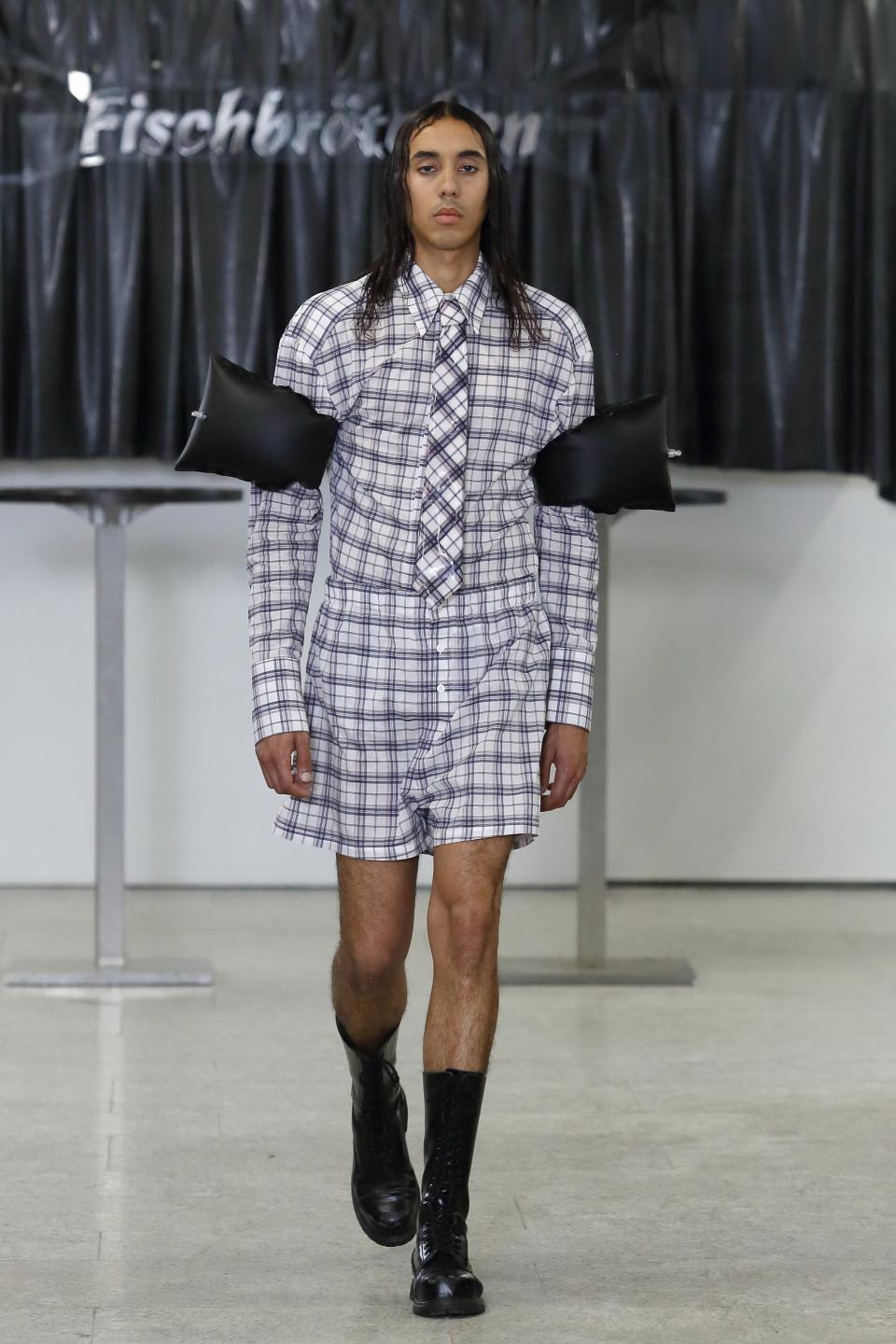
Berlin label Richert Beil, which put on one of the standout shows of the week, is an excellent illustration of both of the aforementioned categories: carefully handcrafted work on top of that distinctive Berlin-outsider creativity.
Their show was called “Bademodeschau,” or “swimwear fashion show” in English. But Richert Beil’s models — like the designers themselves apparently — are uncomfortable in bright summer clothing. They were more interested in wearing checkered, almost transparent, vinyl shorts to the beach, or skintight black denim, or an inflatable black rubber life vest with outsized air-filled shoulders as a top.
The snack stand at Richert Beil’s indoor, urban beach even offered a traditional German seaside snack, a “Fischbroetchen,” or fish sandwich. But in keeping with the darker vibe, it was artistically draped in the kind of thick black rubber sheeting you’re more likely to find covering the sofa in your average Berlin fetish club.
Most of all, though, it was the humorous, inventive and well-constructed detailing in the Richert Beil collection that elevated it beyond an ironic runway concept: The life vest with valves for blowing it up placed exactly over the nipples, that ironic dolphin T-shirt worn under shiny, black vinyl, “fetish” flip-flops with golden spikes and the delicate curve of piping on the buttocks of some rough and ready denim.
So why had they not taken their 10-year-old brand international yet? They clearly have it in them.
“We have talked about it,” Michele Beil, one of the designers responsible for the brand, told WWD backstage after the show. “It was always the plan. But right now we have the feeling that we’re in a really good community in Berlin. Things have really been changing the last few seasons.”
“It’s really lovely here. We support each other here but we also push each other,” Jale Richert, the other half of the label’s design team, added. Anyway, she said knowingly, “there was never a lack of talent here in Berlin, just a lack of organization.”
The Best of Berlin Fashion Week Spring 2025



Launch Gallery: The Best of Berlin Fashion Week Spring 2025
Best of WWD


